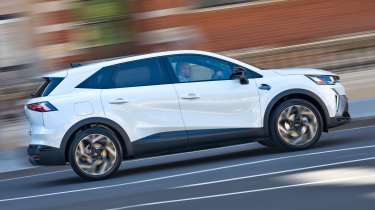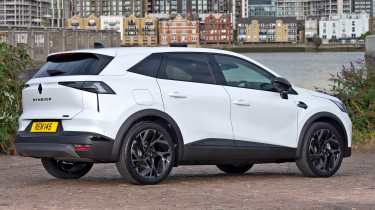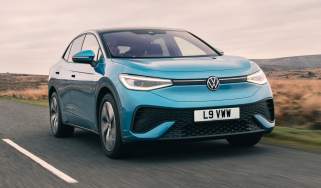Renault Symbioz review – a great-value all-round family SUV
“The Renault Symbioz is a welcome addition to the brand’s range as a family SUV offering great value for money”
Pros
- Comfortable
- Well equipped
- Good value
Cons
- Unremarkable interior
- Dull to drive
- The rear seats can be a squeeze
Verdict – is the Renault Symbioz a good car?
The Renault Symbioz is everything you’d expect from a family SUV; it’s comfortable, efficient and well equipped with good infotainment. Renault only offers it as a frugal hybrid, and yet it’s still inexpensive to buy, which is impressive. While we suspect it will be flexible enough for most buyers, it’s not the most practical car in its class, and other rivals are nicer to drive, with the Symbioz’s focus firmly on comfort. The Symbioz is a great all-rounder, even if it doesn’t dominate in one area in particular.
Renault Symbioz models, specs and alternatives
The Renault Symbioz is a brand-new nameplate for the French carmaker and is a mid-sized family SUV that sits above the Captur and Arkana in its lineup. The name Symbioz is unusual, but is said to come from the Greek word ‘symbiosis’ which means ‘living together’ – that’s an ethos that the brand is hoping the car fulfils by facilitating family life.
The Symbioz starts from just over £29,000 and goes up against other family SUVs like the Nissan Qashqai, Hyundai Tucson and Kia Sportage, bringing an extra edge of French styling flair and fuel efficient full-hybrid tech as standard. It’s off to a good start because it costs almost £1,000 less than the best-selling Nissan Qashqai and undercuts the e-Power hybrid model by a significant £5,000.
There’s just the one hybrid option available: the E-Tech full hybrid 145 with 143bhp produced from a 1.6-litre engine and electric motor. It’s the same system used in the Renault Captur, and drives the front wheels.
The Symbioz can be had in one of three trims: Techno, Techno Esprit Alpine and Iconic Esprit Alpine. All models feel well equipped, getting a 10.4-inch infotainment screen with Google-based software that’s easy to use, as well as Android Auto and Apple CarPlay compatibility. There’s also a digital gauge cluster, wireless smartphone charging, a reversing camera and parking sensors all round, so the Symbioz never feels spartan.
When it was crash-tested in September 2024 by Euro NCAP, the Renault Symbioz received a four-star rating. That’s not to be sniffed at, but many rivals do offer the full five stars for extra peace of mind. Renault as a brand hasn’t been impressing its buyers, with the company coming in a lowly 28th out of 32 manufacturers in the 2024 Driver Power customer satisfaction survey.
|
Trim levels |
Power options |
|
|
MPG, running costs & CO2 emissions
The Renault Symbioz comes with just one powertrain option, and that’s an E-Tech hybrid set up consisting of a 1.6-litre engine paired to an electric motor. The ultimate goal here is frugal fuel economy, and with official mpg figures in the early 60s, it’s safe to say the Symbioz is a fuel-sipper.
The hybrid system uses a 1.2kWh battery and does not need charging up – that power is provided by the starter generator motor and regenerative braking which puts some of the energy usually lost to braking back into the battery.
|
Model |
Fuel economy |
CO2 emissions |
|
E-Tech hybrid 145 |
60.1mpg |
105-107g/km |
How efficient is the Renault Symbioz in the real world?
When we tested the Renault Symbioz in Spain we actually beat the official fuel economy figure provided by Renault, returning 61.4mpg across a mixture of different road types. We actually feel like fuel economy could top around 70mpg if you spend the majority of your time driving around town, as the electric motor is able to do more of the work at lower speeds.
How much will the Renault Symbioz cost in tax?
The Renault Symbioz will cost the discounted annual rate of VED (road tax) because it classifies as an ‘alternative fuel’ vehicle. That means you’ll pay £180 annually, rather than £190 for conventional petrol and diesel models. Thankfully, all versions of the Renault Symbioz start from under £40,000, so you won’t have to pay the extra tax surcharge for cars costing over that threshold.
What will the Renault Symbioz cost to insure?
Official insurance group ratings are yet to be confirmed for the Renault Symbioz, but for context the Nissan Qashqai ranges between groups 11 and 26. The e-Power hybrids are more closely comparable to the Symbioz because of their powertrains, and these range from 24 to 26. It remains to be seen how the Symbioz compares.
Engines, drive & performance
The Symbioz always starts in EV mode and as a result it feels very EV-like to drive, with instant acceleration from a standstill. It feels great to drive around town because of how little the combustion engine has to chime in. Going into ‘B’ mode amps up the regenerative braking feature, which harvests the energy that would otherwise be lost to braking and puts it back into the battery. We’re impressed with the way the Symbioz switches between petrol and electric power as it’s very smooth and seamless.
The steering in the Symbioz feels weightier and slower than that of other Renaults we’ve tested in recent times, but that hasn’t come at the expense of around-town manoeuvrability. While it may be longer, the Symbioz is the same width as the Captur, so it doesn’t feel difficult to drive in tighter spaces. One drawback is the Symbioz’s small rear windscreen, however, and the image from the rear-view camera is of disappointingly low quality, too.
Pushing the Symbioz up to motorway speeds exposes its combustion engine’s drone, which affects the car’s refinement, but once up to speed it settles down and fades away into the background. There was a little wind noise, too, but the Symbioz does offer a comfortable ride, even on our test car’s 19-inch wheels. The Symbioz even coped well with the occasional pothole which it ironed out effectively.
On B-roads, the Renault Symbioz isn’t the most engaging car to drive, although it does feel capable enough. It’s composed, with very little body roll, and the regenerative braking effect and mechanical brakes feel natural to use through the corners, but ultimately this is not a car designed to be fun to drive.
Notably, once the self-charging battery does run out of juice, the combustion engine has to do more of the work, and it's in those moments where the Symbioz feels a bit lacklustre. Up hills with a steep incline it feels as though it has to work very hard and lacks power. There’s an ‘E-Save function’ which you can engage to instruct the Symbioz to reserve at least 40% charge of the battery when you want to use it at different parts of your journey; a feature more typically seen in plug-in hybrid models.
Hybrid model
Buying a Renault Symbioz is quite simple because there’s just the one hybrid system available, with no other engine options to choose from. It’s the same 1.6-litre engine paired with an electric motor as in the smaller Renault Captur, and it’s called the E-Tech 145. This produces 143bhp and sends all its power to the front wheels.
|
Model |
Power |
0-62mph |
Top speed |
|
E-Tech hybrid 145 |
143bhp |
10.6 seconds |
106mph |
Interior & comfort
If you’ve ever been inside a Renault Captur, then the cabin of the Renault Symbioz will feel quite familiar. It’s functional first and foremost, while the design is clean and well laid out. While this is good news for usability, it’s not the most exciting on the market, and rivals such as the Kia Sportage offer a little more pizzazz in this area. It’s a shame Renault didn’t take some cues from the interiors of other models in its lineup, such as the Megane or Scenic EVs.
On a more positive note, build and material quality are very good, and there’s a pleasing amount of soft-touch materials. Going for any model aside from the base Techno trim brings a slightly upgraded interior finish made of fabric that’s composed of 26% recycled fabric, as well as a dashboard panel with textured fabric and a blue gradient finish.
Is the Renault Symbioz’s infotainment and sat-nav system easy to use?
The Renault Symbioz gets the brand’s latest infotainment system displayed on a 10.4 portrait-oriented touchscreen which is sharp and responsive. There’s also a 10.25-inch configurable digital driver’s display. The Renault OpenR infotainment operating system is brilliant and is built on Google’s Android Automotive software, meaning it’s easy to use and navigate because it’s laid out like a smartphone.
Google Maps and Google Assistant are built into the system by default, but you can also download an additional 50 apps, such as Waze and Spotify through the Google Play store. If you prefer to use Android Auto or Apple CarPlay software, you can do so by linking your phone wirelessly.
Cabin temperature is displayed on the infotainment screen, but we’re happy to see that there’s a bank of physical buttons for climate control below it, as well as on the steering wheel. The wireless smartphone charging pad is out of sight, which means you won’t be distracted by incoming notifications, and the cabin doesn’t feel cluttered.
Key features | |
|
Techno
|
Techno Esprit Alpine (Techno plus…)
|
|
Iconic Esprit Alpine (Techno Esprit Alpine plus…)
| |
Boot space, practicality & dimensions
The Renault Symbioz is essentially an elongated version of the Renault Captur, and as a result it’s just as wide as that car. In fact, against rivals such as the Nissan Qashqai, Hyundai Tucson and Kia Sportage it’s the narrowest in size.
We were impressed with the amount of space on offer in the interior for four, even with six-foot tall adults up front and in the back – there’s lots of legroom and space under the front seats for rear passengers, and headroom was also plentiful. The problem is that the narrowness of the car makes itself known when you try to get a further passenger in the middle rear seat, as it can be a bit of a squeeze for three adults.
|
Size comparison | |||
|
Model |
Length |
Width |
Height |
|
Renault Symbioz |
4,413mm |
1,797mm |
1,575mm |
|
Nissan Qashqai |
4,425mm |
1,835mm |
1,625mm |
|
Hyundai Tucson |
4,510mm |
1,865mm |
1,650mm |
|
Kia Sportage |
4,515mm |
1,865mm |
1,650mm |
Does the Renault Symbioz have a big boot?
The Renault Symbioz has a little less boot space than the best-selling Nissan Qashqai, but it features a sliding rear bench that can be pushed forward by 16cm. Doing so frees up 624 litres, so if you’ve got smaller rear-seat passengers and need the extra boot space it offers that versatility. There’s a height-adjustable boot floor, and folding down the rear seats gives you a useful 1,582 litres of boot space. Neither the Qashqai nor the Symbioz can quite compete with the Hyundai Tucson or Kia Sportage, though, as they offer much more boot space, so the Symbioz’s practicality isn’t exactly class-leading.
|
Boot space comparison | |
|
Model |
Boot space |
|
Renault Symbioz |
492 litres (1,582 litres with seats down) |
|
Nissan Qashqai |
504 litres (1,447 litres with seats down) |
|
Hyundai Tucson |
620 litres (1,799 litres with the seats down) |
|
Kia Sportage |
562 litres (1,751 litres with the seats down) |
Reliability & safety
The Renault Symbioz is a brand new name for the brand so it doesn’t yet feature on the Driver Power customer satisfaction survey. However, it shares lots of components with the Captur which last featured in the 2023 edition, coming 34th out of 75 cars. The infotainment and reliability was highly praised, which should be good news for the Symbioz.
Renault as a brand came in a disappointing 28th place out of 32 brands in the manufacturer-specific survey. 24% of owners reported an issue with their Renault in the first year, which is just slightly worse than average.
How safe is the Renault Symbioz?
The Renault Symbioz was tested by Euro NCAP in September 2024 and received a four-star safety rating. While that’s by no means bad, many rivals boast five stars, so if safety is the priority you might want to look elsewhere. Its highest score was in the child occupant protection category, where it achieved 80% – adult occupant protection was awarded 73%. The Symbioz got 76% in the vulnerable road user category, while its safety assistance tech got the lowest score of the four categories at 69%.
The Symbioz gets features including Active Driver Assist, which has Level 2 autonomous driving capabilities which combine adaptive cruise control, lane centring and traffic sign recognition. It’s even able to move over slightly within its lane to leave room for approaching motorbikes.
Autonomous emergency braking, blind-spot warning, lane-departure warning and a driver attention monitor are also fitted. There’s a useful button fitted to the Symbioz and many other recent Renault cars called the ‘My Safety’ button which you can click twice to activate a personalised mode, should you prefer to keep certain features turned off or on and to which levels.
The Symbioz has a system that encourages you to drive more safely, too. Called ‘Safety Coach’ it ranks your driving in real time and gives you a score out of 100. If, say, you’re driving too close to the car up ahead or you’re not keeping your eyes on the road enough, it will alert you. During our test of the Symbioz we never received any alerts from the system, so it seems it’s calibrated to be as unobtrusive as possible, which we liked.
Should you buy a Renault Symbioz?
We think the Renault Symbioz is a great-value mid-size SUV that offers a little more in the way of style than cars like the Nissan Qashqai that have become such a common sight on UK roads. It comes with fuel-sipping hybrid tech that makes it seem like a bargain when you compare it to the hybrid versions of rivals which cost more.
It’s not perfect, though, because while the interior is well laid out and ergonomic, it’s also a bit plain to look at compared with the more outlandish designs offered in cars like the Kia Sportage that bring more interest to the cabin.
The decision to base the Symbioz on the same platform as the Captur – albeit lengthened – means that while there’s more legroom for four adult occupants, the car is narrow and the middle rear seat is quite tight. The Symbioz also has a very middling boot in terms of capacity, so it’s not the class-leader for practicality.
The Renault Symbioz is unremarkable to drive – it’s perfectly comfortable and smooths out the imperfections on UK roads, but it’s not the most enjoyable to drive. In reality that will only be a negative for keen drivers, and as a tool for getting around it does a good job, and after all, that’s what Renault’s ‘voitures à vivre’ (cars for living) ethos is all about.
What is the Carbuyer pick of the Renault Symbioz range?
Choosing an engine for the Symbioz is easy because, well, there’s only the one hybrid E-Tech 145 on the menu. With that out the way, we’d actually be happy with the tech on offer in the base Techno model, but the Symbioz is affordable from the get-go, so you could spring for the mid-range Techno Esprit Alpine with its larger alloys and useful adaptive cruise control and heated seats or even the top-of-the-range Iconic Esprit Alpine and it would still cost less than the Nissan Qashqai e-Power hybrid.
Renault Symbioz alternatives
The Renault Symbioz joins a competitive mid-size SUV market with the most obvious and most common rival the Nissan Qashqai. There’s lots of choice here and many rivals offering hybrid tech, too, but the Symbioz does arguably add an extra ‘je ne sais quoi’ to the sector.
How we tested the Renault Symbioz
We tested a left-hand drive version of the Renault Symbioz in Valencia, Spain in early July 2024 on smooth roads.
Which Is Best?
Cheapest
- Name1.6 E-Tech FHEV 145 Techno 5dr Auto
- Gearbox typeSemi-auto
- RRP£29,290
Most Economical
- Name1.6 E-Tech FHEV 145 Techno Esprit Alpine 5dr Auto
- Gearbox typeSemi-auto
- RRP£31,290
Fastest
- Name1.6 E-Tech FHEV 145 Techno 5dr Auto
- Gearbox typeSemi-auto
- RRP£29,290























